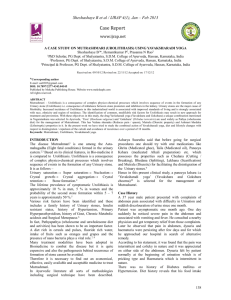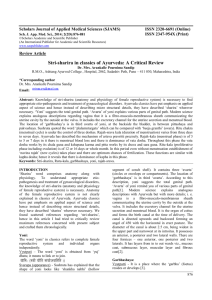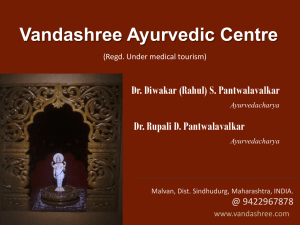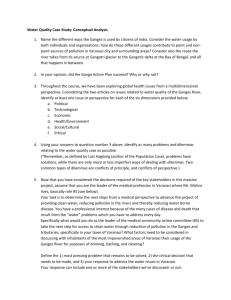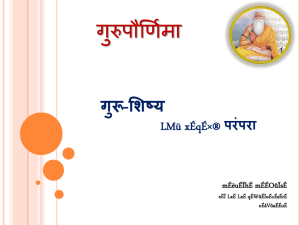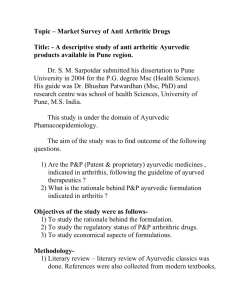CANCER: AN AYURVEDIC OUTLOOK
advertisement
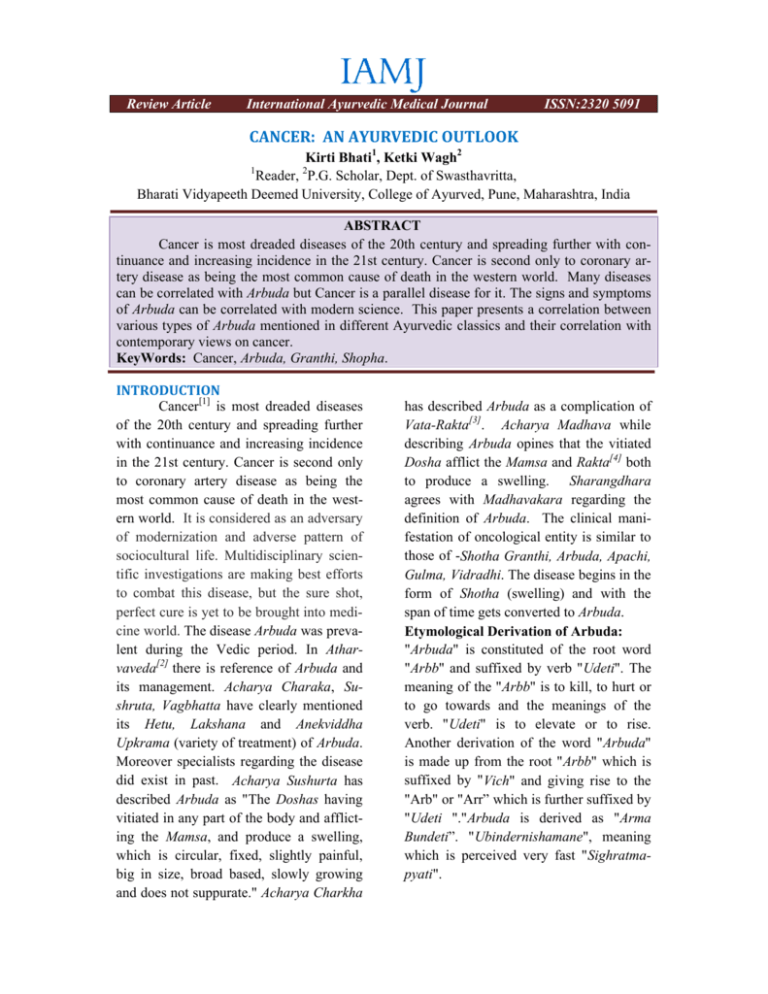
Review Article International Ayurvedic Medical Journal ISSN:2320 5091 CANCER: AN AYURVEDIC OUTLOOK Kirti Bhati1, Ketki Wagh2 1 Reader, 2P.G. Scholar, Dept. of Swasthavritta, Bharati Vidyapeeth Deemed University, College of Ayurved, Pune, Maharashtra, India ABSTRACT Cancer is most dreaded diseases of the 20th century and spreading further with continuance and increasing incidence in the 21st century. Cancer is second only to coronary artery disease as being the most common cause of death in the western world. Many diseases can be correlated with Arbuda but Cancer is a parallel disease for it. The signs and symptoms of Arbuda can be correlated with modern science. This paper presents a correlation between various types of Arbuda mentioned in different Ayurvedic classics and their correlation with contemporary views on cancer. KeyWords: Cancer, Arbuda, Granthi, Shopha. INTRODUCTION Cancer[1] is most dreaded diseases of the 20th century and spreading further with continuance and increasing incidence in the 21st century. Cancer is second only to coronary artery disease as being the most common cause of death in the western world. It is considered as an adversary of modernization and adverse pattern of sociocultural life. Multidisciplinary scientific investigations are making best efforts to combat this disease, but the sure shot, perfect cure is yet to be brought into medicine world. The disease Arbuda was prevalent during the Vedic period. In Atharvaveda[2] there is reference of Arbuda and its management. Acharya Charaka, Sushruta, Vagbhatta have clearly mentioned its Hetu, Lakshana and Anekviddha Upkrama (variety of treatment) of Arbuda. Moreover specialists regarding the disease did exist in past. Acharya Sushurta has described Arbuda as "The Doshas having vitiated in any part of the body and afflicting the Mamsa, and produce a swelling, which is circular, fixed, slightly painful, big in size, broad based, slowly growing and does not suppurate." Acharya Charkha has described Arbuda as a complication of Vata-Rakta[3]. Acharya Madhava while describing Arbuda opines that the vitiated Dosha afflict the Mamsa and Rakta[4] both to produce a swelling. Sharangdhara agrees with Madhavakara regarding the definition of Arbuda. The clinical manifestation of oncological entity is similar to those of -Shotha Granthi, Arbuda, Apachi, Gulma, Vidradhi. The disease begins in the form of Shotha (swelling) and with the span of time gets converted to Arbuda. Etymological Derivation of Arbuda: "Arbuda" is constituted of the root word "Arbb" and suffixed by verb "Udeti". The meaning of the "Arbb" is to kill, to hurt or to go towards and the meanings of the verb. "Udeti" is to elevate or to rise. Another derivation of the word "Arbuda" is made up from the root "Arbb" which is suffixed by "Vich" and giving rise to the "Arb" or "Arr” which is further suffixed by "Udeti "."Arbuda is derived as "Arma Bundeti”. "Ubindernishamane", meaning which is perceived very fast "Sighratmapyati". Kirti Bhati & Ketki Wagh: Cancer: An Ayurvedic Outlook SIMILARITY BETWEEN ARBUDA AND CANCER: Many diseases can be correlated with Cancer but Arbuda is a parallel disease for it. The signs and symptoms of Arbuda can be correlated with modern science. Gatra pradeshe kavachita: Anywhere in the body or any tissue may be damaged. Mamsamabhi pradushyam: Predominantly it is a disease of the Mamsa that is damage of the muscular connective and epithelial tissues. Vrutam sthiram: The growth is round and stony hard. Manda rujam: Pain is not present except in final stage. Mahantam: It spreads with deep route. Chira vrudhi: It is chronic in nature and gradual in progress. Apakam: It is non-suppressive. Mamshrochhayam: Tumor is formed by unnecessary and uncontrolled abnormal proliferation of tissue. Atyagadham: Very deep rooted. CONCEPTUAL REVIEW: MODERN[6] Metastatic - the tumor can send cells into other tissues in the body, which may be distant from the original tumor. The original tumor is called the "primary tumor." Its cells, which travel through the body, can begin the formation of new tumors in other organs. These new tumors are referred to as "secondary tumors." The cancerous cells travel through the blood (circulatory system) or lymphatic system to form secondary tumors. The lymphatic system is a series of small vessels that collect waste from cells, carrying it into larger vessels, and finally into lymph nodes. Lymph fluid eventually drains into the bloodstream. Cancer is named after the part of the body where it originated. When cancer spreads, it keeps this same name. For example, if kidney cancer spreads to the lungs, it is still kidney cancer, not lung cancer. (The 959 www.iamj.in lung cancer would be an example of a secondary tumor.) Staging is the process of determining whether cancer has spread and, if so, how far. There is more than one system used for staging cancer, and the definition of each stage will depend on the type of cancer. Cancer is not just one disease but rather a group of diseases, all of which cause cells in the body to change and grow out of control. Cancers are classified either according to the kind of fluid or tissue from which they originate, or according to the location in the body where they first developed. In addition, some cancers are of mixed types. The following five broad categories indicate the tissue and blood classifications of cancer: Carcinoma: A carcinoma is a cancer found in body tissue known as epithelial tissue that covers or lines surfaces of organs, glands, or body structures. For example, a cancer of the lining of the stomach is called a carcinoma. Many carcinomas affect organs or glands that are involved with secretion, such as breasts that produce milk. Carcinomas account for 80 percent to 90 percent of all cancer cases. Sarcoma: A sarcoma is a malignant tumor growing from connective tissues, such as cartilage, fat, muscle, tendons, and bones. The most common sarcoma, a tumor on the bone, usually occurs in young adults. Examples of sarcoma include osteosarcoma (bone) and chondrosarcoma (cartilage). Lymphoma: Lymphoma refers to a cancer that originates in the nodes or glands of the lymphatic system, whose job it is to produce white blood cells and clean body fluids, or in organs containing glands of the lymphatic system or nodes. Lymphomas are IAMJ: Volume 3; Issue 3; March- 2015 Kirti Bhati & Ketki Wagh: Cancer: An Ayurvedic Outlook classified into two categories: Hodgkin‘s lymphoma and non-Hodgkin‘s lymphoma. Leukemia: Leukemia, also known as blood cancer, is a cancer of the bone marrow that keeps the marrow from producing normal red and white blood cells and platelets. White blood cells are needed to resist infection. Red blood cells are needed to prevent anemia. Platelets keep the body from easily bruising and bleeding. Broadly examples of leukemia include acute myelogenous leukemia, chronic myelogenous leukemia, acute lymphocytic leukemia, and chronic lymphocytic leukemia. The terms myelogenous and lymphocytic indicate the type of cells that are involved. Myeloma: Myeloma grows in the plasma cells of bone marrow. In some cases, the myeloma cells collect in one bone and form a single tumor, called a plasmacytoma. However, in other cases, the myeloma cells collect in many bones, forming many bone tumors. This is called multiple myeloma. Causes: There is no one single cause for cancer. Scientists believe that it is the interaction of many factors together that produces cancer. The factors involved may be genetic, environmental, or constitutional characteristics of the individual. Diagnosis, treatment, and prognosis for childhood cancers are different than for adult cancers. The main differences are the survival rate and the cause of the cancer. The survival rate for childhood cancer is about 79 percent, while in adult cancers the survival rate is 64 percent. This difference is thought to be because childhood cancer is more responsive to therapy, and a child can tolerate more aggressive therapy. Childhood cancers often occur or begin in the stem cells, which are simple cells capable of producing other types of specialized 960 www.iamj.in cells that the body needs. A sporadic (occurs by chance) cell change or mutation is usually what causes childhood cancer. In adults, the type of cell that becomes cancerous is usually an "epithelial" cell, which is one of the cells that line the body cavity, including the surfaces of organs, glands, or body structures, and cover the body surface. Cancer in adults usually occurs from environmental exposures to these cells over time. Adult cancers are sometimes referred to as "acquired" for this reason. Risk Factors: As mentioned, some cancers, particularly in adults, have been associated with certain risk factors. A risk factor is anything that may increase a person's chance of developing a disease. A risk factor does not necessarily cause the disease, but it may make the body less resistant or more susceptible to it. Persons who have an increased risk of developing cancer can help to protect themselves by scheduling regular screenings and check-ups with their physician and avoiding certain risk factors. Cancer treatment has been proven to be more effective when the cancer is detected early. The following risk factors and mechanisms have been proposed as contributing to the development of cancer: Lifestyle: Lifestyle and environmental factors such as smoking, high-fat diet, exposure to ultraviolet light (UV radiation from the sun), or exposure to chemicals (cancer-causing substances) in the work place over long periods of time may be risk factors for some adult cancers. Most children with cancer, however, are too young to have been exposed to these lifestyle factors for any extended time. Genetic: Family history, inheritance, and genetics may play an important role in some adult and childhood cancers. It is possible for IAMJ: Volume 3; Issue 3; March- 2015 Kirti Bhati & Ketki Wagh: Cancer: An Ayurvedic Outlook cancer of varying forms to be present more than once in a family. Some gene alterations are inherited. However, this does not necessary mean that the person will develop cancer. It indicates that the chance of developing cancer increases. It is unknown in these circumstances if the disease is caused by a genetic mutation, other factors, or simply coincidence. Virus: Exposures to certain viruses, such as the human papillomavirus (HPV) and human immunodeficiency virus (HIV; the virus that causes acquired immune deficiency, or AIDS), and the herpes virus have been linked to an increased risk of developing certain types of cancers. Possibly, the virus alters a cell in some way. That cell then reproduces an altered cell and, eventually, these alterations become a cancer cell that reproduces more cancer cells. Cancer is not contagious and a person cannot contract cancer from another person who has the disease. Environmental: Environmental exposures such as uranium mines, pesticides, fertilizers, and power lines have been researched for a direct link to childhood cancers. There has been evidence of cancer occurring among nonrelated children in certain neighborhoods and/or cities. Whether prenatal or infant exposure to these agents causes cancer, or whether it is a coincidence, is unknown. How Genes affect cancer: The discovery of certain types of genes that contribute to cancer has been an extremely important development for cancer research. Over 90 percent of cancers are observed to have some type of genetic alteration. A small percentage (5 percent to 10 percent) of these alterations are inherited, while the rest are sporadic, which means they occur by chance or occur from environmental exposures (usually over 961 www.iamj.in many years). There are three main types of genes that can affect cell growth, and are altered (mutated) in certain types of cancers, including the following: Oncogenes: These genes regulate the normal growth of cells. Scientists commonly describe oncogenes as similar to a cancer "switch" that most people have in their bodies. What "flips the switch" to make these oncogenes suddenly become unable to control the normal growth of cells and allowing abnormal cancer cells to begin to grow, is unknown. Tumor suppressor genes: These genes are able to recognize abnormal growth and reproduction of damaged cells, or cancer cells, and can interrupt their reproduction until the defect is corrected. If the tumor suppressor genes are mutated, however, and they do not function properly, tumor growth may occur. Mismatch-repair genes: These genes help recognize errors when DNA is copied to make a new cell. If the DNA does not "match" perfectly, these genes repair the mismatch and correct the error. If these genes are not working properly, however, errors in DNA can be transmitted to new cells, causing them to be damaged. Usually the number of cells in any of our body tissues is tightly controlled so that new cells are made for normal growth and development, as well as to replace dying cells. Ultimately, cancer is a loss of this balance due to genetic alterations that "tip the balance" in favor of excessive cell growth. PATHOPHYSIOLOGY OF CANCER: AYURVEDIC VIEW: As per the description available with the texts, no specific etiology is mentioned. Charaka and Vagbhatta included this disease under the heading of Shopha Roga. Both these authors are unanimous in their IAMJ: Volume 3; Issue 3; March- 2015 Kirti Bhati & Ketki Wagh: Cancer: An Ayurvedic Outlook opinion that the etiological factors, which are responsible for Shopha, are also responsible for Arbuda considering the relation between inflammation and neoplasia. Further Charaka has also mentioned that the etiological factors, site, shape, dosha and Dushya of Arbuda are the same as in case of Granthi. Acharya Sushruta while dealing with the Arbuda says that causative factors and clinical features are same as of Granthi. Nidana: Purvarupa: Acharya Vagbhatta mentioned that the swelling of Granthi, which is smaller in comparison to that of Arbuda, should be considered as Purvarupa of Arbuda.[7] Rupa: Acharya Sushruta states that Arbuda is mainly due to the vitiation of the Tridosha, where Kapha and Meda have been considered in a predominant state, due to which Arbuda does not get suppurated[8]. Based on Doshas: Vatika Arbuda[9]: The Arbuda of Vata origin produces a feeling of stretching, pain, pricking and (falling) as if being thrown and also cutting and tearing pains. It is black and hard and is like a bladder distended with air. Paitikka Arbuda[10]: The Arbuda due to Pitta produces a sensation of severe burning, fuming, sucking, throbbing and as if being burnt to ashes. Kaphaja Arbuda[11]: The Arbuda due to vitiation of Kapha produce a cold swelling without any discoloration associated with mild pain and excessive itching having the consistency of a stone. Based on Dushya: Medo Arbuda[12]: The Arbuda due to Medas increases or decreases according to the increase or decrease of fat in the body; it is smooth, big in size and is associated with mild pain and excessive itching. Rakta Arbuda[13]: The vitiated Dosha compressing and contracting the sonata 962 www.iamj.in and vessels without undergoing suppuration and along with the discharge make the muscular lump prominent. This is studded with fleshy buds and increases rapidly. This continuously discharges vitiated blood and is in curable. Because of the complication of hemorrhage the patient with this tumor becomes anemic. Mamsa Arbuda[14]: Due to fist blows etc. the muscle of the injured parts get vitiated and swollen. This is painless and smooth, is of the same colour (as skin), is non suppurating, is like stone and is fixed. This vitiated muscle increases more in non vegetarian. This is said to be incurable. Even out of those which are curable, those which discharge, those situated over the vital parts or over the srotas and those which become, fixed should be discarded from treatment. Adhyarbuda & Dwirarbuda[15]: When another tumor grows over the pre-existing one, that is known as Adhyaarbuda. When two tumors grow simultaneously or one after the other, that is called Dwirarbuda, and both these are incurable. Based on Site: Kapal Arbuda[16]: Acharya Vagbhatta has mentioned that there is every likelihood of Arbuda in Shira i.e., Kapalarbuda, no detail description is given. Vartma Arbuda[17]: Irregular, painless and pendulous in nature is Vartmarbuda, characterizes a swelling. It arises in internal surface of the lid due to vitiation of Raktayukta Vatadi doshas. Karna Arbuda[18]: Sushurta has mentioned about Karnarbuda, where ear ache, smelly discharge and deafness are the cardinal symptoms but has not given detailed explanation. Nasa Arbuda[19]: Nasa Arbuda causes difficulty in breathing, frequent sneezing, chronic rhinitis and cold, nasal speech, foul smell from nose and headache. IAMJ: Volume 3; Issue 3; March- 2015 Kirti Bhati & Ketki Wagh: Cancer: An Ayurvedic Outlook [20] Mukha Arbuda : The vitiated Kapha causes this Arbuda inside the Kapola which is pale red in colour. Talva Arbuda[21]: That swelling which is of the shape of lotus, is in the middle of palate, and has features of Raktarbuda. Ostha Arbuda[22]: Vagbhatta has mentioned two types of Ostha Arbuda. 1) Raktarbuda: a disorder of Ostha, where excessive bleeding occurs due to vitiation of Rakta and the Ostha becomes reddish in colour. As a consequence of excessive bleeding and vitiation of Rakta Ostha looks like of Kharjura and is Asadhya. 2) Jalarbuda: the vitiation of Vata and Kapha at the site of osta results in to a swelling of the shape of water bubble and is a Sadhya. Gala Arbuda[23]: Vitiated, doshas produce as welling in the region between posterior of Jihva and in the beginning of Kantha, which is non-suppressive, immobile, and reddish in color and painless and Asadhya. Samprapti[24]: Sushruta proposed six stages in pathogenesis for all diseases in general. But, in specific his concepts suits more to pathology of neoplasms. He might have considered the surgical conditions like Arbuda, Granthi, Apachi, Galaganda etc., and proposed Shat Kriya Kala (six Manifestations in Ayurveda Charmakeel Padminikantaka Sosha / Pandu Medoja Galganda Apachi Agantuja Stanaroga Yakrutodara Pleehodara Raktagulma Rakta, Mamsaja, Medoja,Oshta Roga Kachchapa, Raktarbuda,Mamsa Sanghata Balasa, Gilayu, Kantha Roga Mamsatana Swarabhanga 963 www.iamj.in steps in disease process) which are as follows: Sanchaya: early stages of neoplastic changes i.e., when the growth is only localized. Prakopa: transformation of primary growths into metastatic tumors i.e., invasion. Prasara: metastasis (in the development of cancer stage of invasion is followed by metastasis). Sthana Samsraya: the stage when metastasis is complete and secondaries developed at another place outside the place of origin of the tumor. Vyakti: the stage where clinical sign and symptoms of neoplasm are expressed (usually many tumors remain asymptomatic and obscure till late stages). Bheda: the stage where differentiation of growths is made into specific groups on the basis of histopathology. (The treatment is also planned according to the stage of the disease process). Table No: 1: Showing correlation of various conditions in Ayurvedic Classics to different types of cancer Manifestations in modern medicine Keloid Papilloma of skin Leukaemia Hodgkin's lymphoma Hodgkin's disease Cancer of the breast Hepatomegaly due to liver metastasis Spleenomegaly due to infiltration in spleen Tumors of uterus /ovary Carcinoma of lips Carcinoma Palate Bronchogenic Ca. and lung tumours Tumors of the pharynx Tumors of larynx IAMJ: Volume 3; Issue 3; March- 2015 Kirti Bhati & Ketki Wagh: Cancer: An Ayurvedic Outlook CONCLUSION There is enough scope to explore the role of Ayurveda in the management of cancer by analyzing and comparing various concepts mentioned in ancient texts with current information available in various modern texts with the aim of giving patients relief from undesired effect of cancer like decrease in immunity, decreased quality of life, poor tolerance to surgery, altered efficacy of chemotherapy and radiotherapy. REFERENCES: 1. Davidson’s Principle and Practice of Medicine, 18th edition, p 1050 2. K.L. Joshi, Kandas, Chaukhamba Orientalia Varanasi, 2000, Atharvaveda Samhita 11/9/1-25, p 336-338 3. P.V. Sharma, Agneevesha, Charaka, Dridhbala, Charaka Chikitsa, Chikitsa Sthana (29/32) Chaukambha Orientalia, Varanasi, 1983, p 924 4. Narendra Shastri, Madhavkar, Madhav Nidanam, Motilal Banarsidas Publications, Delhi, 39/18-19, p 543 5. .http://cancer.about.com/od/historyofca ncer/a/cancerhistory.htm Dt. 6/3/10 6. Lalchandra Vaidya, Vagabhata, Motilal Banarsidas Publishers, Delhi, Asthanga Hridayam Uttara Sthana (29/14), p 744 7. Amikadutta Shastri, Sushruta, Nidana Sthana (11/14), Chaukhambha Sanskrit Sansthan, Varanasi, 2001, p 272 8. Amikadutta Shastri, Sushruta, Nidana Sthana (11/14), Chaukhambha Sanskrit Sansthan, Varanasi, 2001, Sushruta Nidana Sthana 11/4m, p 271 9. Amikadutta Shastri, Sushruta, Nidana Sthana (11/14), Chaukhambha Sanskrit Sansthan, Varanasi, 2001, Sushruta Nidana Sthana 11/5, p 271 10. Amikadutta Shastri, Sushruta, Nidana Sthana (11/14), Chaukhambha Sanskrit Sansthan, Varanasi, 2001, Sushruta Nidana Sthana 11/6, p 271 964 www.iamj.in 11. Amikadutta Shastri, Sushruta, Nidana Sthana (11/14), Chaukhambha Sanskrit Sansthan, Varanasi, 2001, Sushruta Nidana Sthana 11/7, p 271 12. Amikadutta Shastri, Sushruta, Nidana Sthana (11/14), Chaukhambha Sanskrit Sansthan, Varanasi, 2001, Sushruta Nidana Sthana 11/15-17, p 273, 274 13. Amikadutta Shastri, Sushruta, Nidana Sthana (11/14), Chaukhambha Sanskrit Sansthan, Varanasi, 2001, Sushruta Nidana Sthana 11/17-19, 273, 274 14. Amikadutta Shastri, Sushruta, Nidana Sthana (11/14), Chaukhambha Sanskrit Sansthan, Varanasi, 2001, Sushruta Nidana Sthana 11/20, p 274 15. Lalchandra Vaidya, Vagabhata, Motilal Banarsidas Publishers, Delhi, Asthanga Hridayam Uttara Sthana (23/21), p 744 16. Lalchandra Vaidya, Vagabhata, Motilal Banarsidas Publishers, Delhi, Asthanga Hridayam Uttara Sthana (8/24) p 626 17. Lalchandra Vaidya, Vagabhata, Motilal Banarsidas Publishers, Delhi, Asthanga Hridayam Uttara Sthana (17/14-15), p 673 18. Lalchandra Vaidya, Vagabhata, Motilal Banarsidas Publishers, Delhi, Asthanga Hridayam Uttara Sthana (19/26), p 985 19. Lalchandra Vaidya, Vagabhata, Motilal Banarsidas Publishers, Delhi, Asthanga Hridayam Uttara Sthana (21/62), p 696 20. Amikadutta Shastri, Sushruta, Chaukhambha Sanskrit Sansthan, Varanasi, 2001, Nidana Sthana (11/14), p 272 21. Lalchandra Vaidya, Vagabhata, Motilal Banarsidas Publishers, Delhi, Asthanga Hridayam Uttara Sthana (21/10), p 690 22. Lalchandra Vaidya, Vagabhata, Motilal Banarsidas Publishers, Delhi, Asthanga Hridayam Uttara Sthana (21/52) p, 695 23. Dr. Prabhakar Chatterjee, Cancer in Ayrveda, 2nd chapter, p 8-9 IAMJ: Volume 3; Issue 3; March- 2015 Kirti Bhati & Ketki Wagh: Cancer: An Ayurvedic Outlook CORRESPONDING AUTHOR Dr. Kirti Bhati Reader, Dept. of Swasthavritta Bharati Vidyapeeth Deemed University College of Ayurved, Pune, Maharashtra, India Email: kirti4bhati@gmail.com Source of support: Nil Conflict of interest: None Declared 965 www.iamj.in IAMJ: Volume 3; Issue 3; March- 2015
